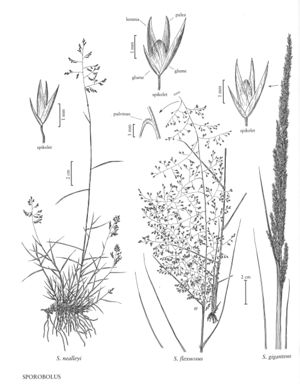Sporobolus giganteus
Plants perennial; cespitose, not rhizomatous. Culms 100-200 cm, (3)4-10 mm thick near the base. Sheaths rounded below, striate, margins hairy distally, apices with conspicuous tufts of hairs, hairs to 2 mm; ligules 0.5-1.5 mm; blades 10-50 cm long, (3)4-10(13) mm wide, flat, glabrous on both surfaces, margins whitish, scabridulous. Panicles all terminal, 25-75 cm long, 1-4 cm wide, spikelike, dense, usually included in the uppermost sheath; lower nodes with 1-2(3) branches; primary branches mostly 0.5-6 cm, appressed or spreading to 30° from the rachis, spikelet-bearing to the base; secondary branches appressed; pulvini glabrous; pedicels 0.5-2 mm, appressed. Spikelets 2.5-3.5(4) mm, whitish to plumbeous. Glumes unequal, narrowly lanceolate, membranous, prominently keeled; lower glumes 0.6-2 mm; upper glumes 2-3.5(4) mm, subequal to the lemmas; lemmas 2.5-3.5(4) mm, linear-lanceolate, membranous, glabrous, acute; paleas 2.4-3.4(3.8) mm, linear-lanceolate, membranous, glabrous; anthers 0.6-1 mm, yellowish. Fruits 0.8-1.7 mm, ellipsoid, light yellowish-brown, sometimes translucent. 2n = 36.
Distribution
Kans., Okla., Colo., N.Mex., Tex., Utah, Ariz.
Discussion
Sporobolus giganteus grows in sand dunes and sandy areas along rivers and roadsides, at elevations from 100-1830 m. Its range extends from the southwestern United States into northern Mexico.
Selected References
None.
